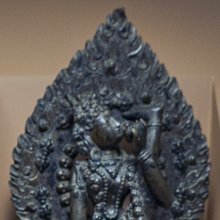Urdhvapada, Ūrdhvapāda, Urdhva-pada: 6 definitions
Introduction:
Urdhvapada means something in Hinduism, Sanskrit. If you want to know the exact meaning, history, etymology or English translation of this term then check out the descriptions on this page. Add your comment or reference to a book if you want to contribute to this summary article.
Images (photo gallery)
In Hinduism
Shaivism (Shaiva philosophy)
Source: Shodhganga: Iconographical representations of ŚivaŪrdhvapāda (ऊर्ध्वपाद) or Ūrdhvapādamūrti refers to one of the twenty-three forms (mūrti) of Śiva mentioned in the Pūrvakāmikāgama (pratimālakṣaṇavidhi-paṭala): first and foremost among the Mūlāgama. The forms of Śiva (e.g., Ūrdhvapāda) are established through a process known as Sādākhya, described as a five-fold process of creation.

Shaiva (शैव, śaiva) or Shaivism (śaivism) represents a tradition of Hinduism worshiping Shiva as the supreme being. Closely related to Shaktism, Shaiva literature includes a range of scriptures, including Tantras, while the root of this tradition may be traced back to the ancient Vedas.
Languages of India and abroad
Sanskrit dictionary
Source: DDSA: The practical Sanskrit-English dictionaryŪrdhvapāda (ऊर्ध्वपाद).—a. having the feet upwards. (-ṇaḥ) 1 A kind of ascetic or devotee.
2) a fabulous animal called Śarabha.
-pādam A kind of dance; Daśakumāracarita 2.8.
Ūrdhvapāda is a Sanskrit compound consisting of the terms ūrdhva and pāda (पाद). See also (synonyms): ūrdhvacaraṇa.
Source: Cologne Digital Sanskrit Dictionaries: Cappeller Sanskrit-English DictionaryŪrdhvapāda (ऊर्ध्वपाद).—[adjective] having the heels upwards; [masculine] the point of the foot.
Source: Cologne Digital Sanskrit Dictionaries: Monier-Williams Sanskrit-English Dictionary1) Ūrdhvapāda (ऊर्ध्वपाद):—[=ūrdhva-pāda] [from ūrdhva] m. the top of the foot, [Hemādri’s Caturvarga-cintāmaṇi]
2) [v.s. ...] mfn. having the feet upward, [Rāmāyaṇa]
3) [v.s. ...] m. the fabulous animal Śarabha (See -caraṇa above).
[Sanskrit to German]
Sanskrit, also spelled संस्कृतम् (saṃskṛtam), is an ancient language of India commonly seen as the grandmother of the Indo-European language family (even English!). Closely allied with Prakrit and Pali, Sanskrit is more exhaustive in both grammar and terms and has the most extensive collection of literature in the world, greatly surpassing its sister-languages Greek and Latin.
See also (Relevant definitions)
Partial matches: Urdhva, Pada, Pata.
Starts with: Urdhvapadamurti.
Full-text: Urdhvapadamurti, Urdhvacarana, Utpadaka.
Relevant text
Search found 1 books and stories containing Urdhvapada, Urdhva-pada, Ūrdhva-pāda, Ūrdhvapāda; (plurals include: Urdhvapadas, padas, pādas, Ūrdhvapādas). You can also click to the full overview containing English textual excerpts. Below are direct links for the most relevant articles:
The Skanda Purana (by G. V. Tagare)
Chapter 62 - The Practice of Mahāvidyā < [Section 2 - Kaumārikā-khaṇḍa]

